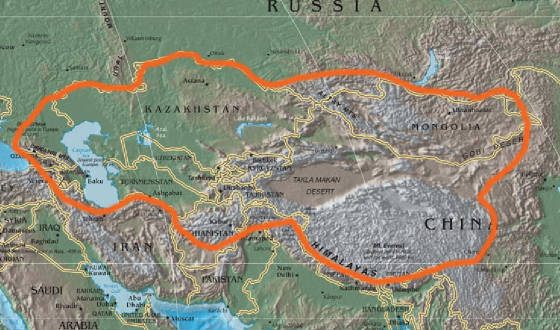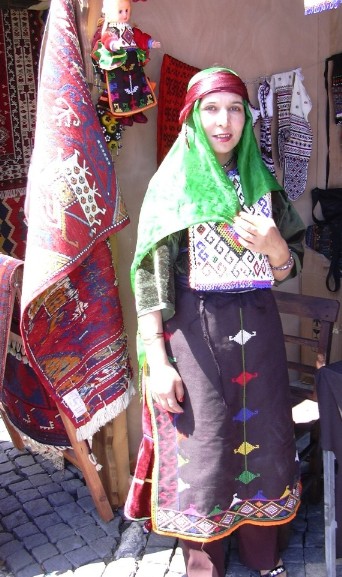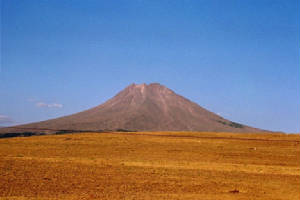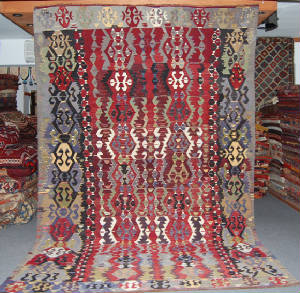|
|
 |
|
Central Asian Roots of Turkish Tribal Art & Textiles

|
| Click on map to enlarge. |
Central Asia is home to the various cultures and peoples who gave rise to the beautiful
tribal textiles and art. It is also the home of the Turkish people, who stayed connected throughout thousands of years. No
wonder we are often flooded by the feeling of deep appreciation for history, tradition, and pride as we gaze at these amazing
works of art.
|
 |
|

From the Far East to Anatolia exists a single culture area, a dreamland of unique art and culture, represented in our lives
by the accidental meeting and subsequent marriage of a Turkish man--a one-time shepherd and tribal art expert-- and a Japanese
woman, a Near Eastern archaeologist. We enjoy sharing our passion for Turkish culture and artifacts, both through information
and by making available unique art pieces from across this vast, exotic land.
Turkey has been the crossroads of civilizations since the earliest of times, due to its location between the Black and
Mediterranean Sea, and where Europe and Asia meet. The Turkish culture is an unique mix of indigenous cultures that developed
in this area, as well as being heavily influenced by the various peoples and cultures that flowed through the region.
Turks refer not just to the people living in Turkey, but rather denotes anyone who speaks a Turkic language. They currently
number about 90 million people and live in areas reaching from China and Russia to Greece and Afghanistan.
The origins of the Turks has very limited factual evidence and much is shrouded in mystery and myths. In the earliest
recorded history of the steppe, they are referred to as being the offspring of wolves.
Some researchers suggest that the first historical references to the Turks appear at around 200 B.C., as Hsiung-nu in
Chinese records. This term, which later became the Hun in our language, refers to people who lived in the region of the Altai
Mountains, Lake Baikal, and the northern edge of the Gobi Desert, modern day Kazakhstan, China, and Mongolia. This region
is dominated by mountains with eternal snow and glaciers, similar to the European Alps. The highest peak, Ak-Sümer, is 4,506
metres (nearly 15,000 feet) high.
These Turks of Altai were mainly nomadic shepherds tending sheep, horses and sometimes camels. Although there is evidence
of agriculture, such as millet seeds and stone grinders from Turkic graves, the basis of their economy was animal herding.
They also mined iron and served as blacksmiths to their overlords, a group of people called the Juan-juan. Being skilled
at many crafts, such as metalworking, woodwork, leather work, and textile-making, the Altai Turks bequeathed an extremely
interesting culture to their descendants, the basic features of which have been handed down from the early beginnings all
the way to the present day.
By the sixth century A.D., the Turks under the leadership of a man named Bumin, had become a strong force. Becoming allies
with the Western Wei dynasty of China, Bumin provoked the Juan-juan into a war and defeated them in 552 A.D. Moving towards
the west and the south, they gained control of the entire Eurasian steppe, with their very mobile and almost undefeatable
mounted bowmen. There are stone statues all over Mongolia, southern Siberia, and Khazakstan, commemorating these ferocious
Turkic warriors. This lead to the first Turkish empire, Turkkhanat. At its highest flowering, this loose grouping of nations
stretched from the Korean Bay to the Caspian Sea and the northern Caucasus, and its northern borders almost reached the Baikal
Sea. Its southern rim touched the Great Wall of China and present-day Tibet.
| Central Anatolian Landscape - Mountain |

|
The greatest cultural achievement of the Turkkhanat was the development of its own writing, or Turkish runes, passed down
to the present day in the inscriptions in the Orchon region of northern Mongolia and the upper Yenisey.
However, like all these early Central Asian states, this Turkish empire was based on a loose alliance of various nomadic
tribes and was from the start in danger of internal collapse. Therefore, after Bumin's death in 553, Turkkhanat was split
into two, the eastern and the western parts. The eastern part, the Eastern Turkic Khaganate, ruled by his son Mu han, defeated
the Khitans in the east and overtook the north Chinese kingdoms. This lead to heavy influence from the Chinese cultures.
At the same time the western part, the Western Turkic Khaganate ruled by Bumin's brother Ishtemi, expanded as well, reaching
as far as the Ili and Chu rivers. Ishtemi, then in cooperation with the Sassanids of Persia (modern-day Iran), conquered
the Hephtalite empire of Central Asia in 560 A.D., stretching his land until it was in direct contact with Byzantium and in
control of the silk trade between China and the West.
This prosperous location on the Silk Road enabled the Western Turkic Khaganate to remain as the central seat of civilization
in Central Asia, with ambassadors sent from Byzantine and China. The western Turks made treaties with the Sassanids and Byzantines,
enabling them to offer security to the caravans traveling through Central Asia carrying silk and other commodities, such as
lacquerware, from the East to the West.
However, by 630 A.D. the Eastern Turkic Khaganate had fallen under the power of the Chinese Sui Dynasty due to a long
period of decadence. Thus strengthened, the Chinese moved into the Western Turkic Khaganate following the death of T'ing
Shih-hu, the khan of the Western Turkic Khaganate, and the chaos that followed. By 659 A.D., the Chinese had taken over as
far as Bukhara and Samarkand. However, when the Chinese ruler Kao-tsung died a few years later, the eastern Turks revolted
in 683 A.D. under the leadership of Elterish. Elterish not only needed to fight the dominance of the Chinese, but also had
to fight with other hostile Turkic tribes, such as the Tolos and the Turgash, as well as the Arabs. However, by 691 A.D.,
the Turkish empire was able to reestablish itself on the eastern steppe. When Elterish's brother Qapaghan became Khagan,
he was able to finally reunify the western and eastern groups, finally reestablishing the original Turkic empire. Unfortunately,
this new empire was again constantly plagued by internal stresses and external threats, as well as economic problems.
|
 |
|
|
 |
|
| West Turkey Usak Kilim |

|
| Carpet ID: HYA305. Price: SOLD |
With the death of the next Khagan, Bilge, in 734, the Turkic empire fell apart again. This time, three Turkic tribes, the
Basmil, Karluk, and Uighurs, competed with each other and the Altai Turks for control over the Central Asian steppe. In 745
A.D., the Uighurs finally came out victorious and created their own state with their great walled capital, Karabalghaun.
Excavations have testified to the high flowering of the Turkish culture before and during the reign of the Uighurs. Their
religion was Manichaeic and they had a particularly fine tradition of painting. The Uighurs were driven out in 840 A.D. by
the Kirghiz, but at about this time a new force was spreading into Central Asia: Islam, the religion which still today dominates
the western part of this region and which even reached India in the 8th century, carried by invading Arabs.
After the Uighurs, there were no further examples of unity among all of the Turkic tribes of Central Asia. A period of
instability followed, with individual kingdoms and much movement towards the Russian steppe and the Middle East, which continued
until the Mongol Empire in the 12th century. At the same time, nomadic life was gradually abandoned and Islam was adopted
as the main religion. Islam became a major shared aspect of the Turkic culture, along with their history and language.
Islam became a major factor that led Turkic raids into India and the Middle East. The Oguz Turks, who quickly embraced
Islam, established themselves under their khan, Seljuk, in the region of Bukhara. One of these branches moved west to enter
into the service of the Abbasid caliphs (religious leaders of Islam) of Baghdad and organized themselves into tribal bands
of horsemen to defend the frontiers of the caliphate. However, in 1055 A.D., Tugrul Bey, a Seljuk khan, occupied Baghdad
at the head of an army and forced the caliph to recognize him as sultan, a temporal leader, of Persia and Mesopotamia. However,
in the time of Tugrul Bey, Mehmet ibn Daud (also, Alp Aslan, the Lion Hero), the Seljuk elite could no longer control their
slave soldiers, who they depended on heavily. The slave soldiers moved towards Anatolia from the bureaucratic Persian state,
in search of more freedom. Gradually, the slave soldiers moved into the Byzantine territory, raiding, serving as mercenaries
in the private wars of Byzantine nobles, and occasionally settling on the land they had taken. The Seljuk elite followed
them into Anatolia in order to attempt to regain control over their slave soldiers. In A.D. 1071, Arp Aslan conquered the
Byzantine army near Lake Van, opening all of Anatolia to conquest by the Turks.
Meanwhile, the Kirghiz Turks and Uighur Turks s were struggling with each other and the Chinese Empire. The Kirghiz people
finally settled in current Kyrgyzstan. Tartar Turks settled in what is today Tatarstan, following the western movement of
the Mongols under Genghis Khan (or Temujin) in the 13th century. Everywhere, Turkic groups mixed to some extent with other
local populations.
|
 |
|
|
|
|
All rugs and other items pictured are available for sale, unless otherwise noted.
The free shipping is for 4-10 day delivery through an insured delivery method.
To receive express
shipping prices (extra cost may be required) and other information, please e-mail us.
ADDRESS: NOAH'S ARK CARPETS AND KILIMS. DIVANYOLU CAD,TICARETHANE SOK. NO:5A, ISTANBUL,
TURKEY. 34410,USA 789 Orange st,New Haven CT.06517
|
|
|
 |

